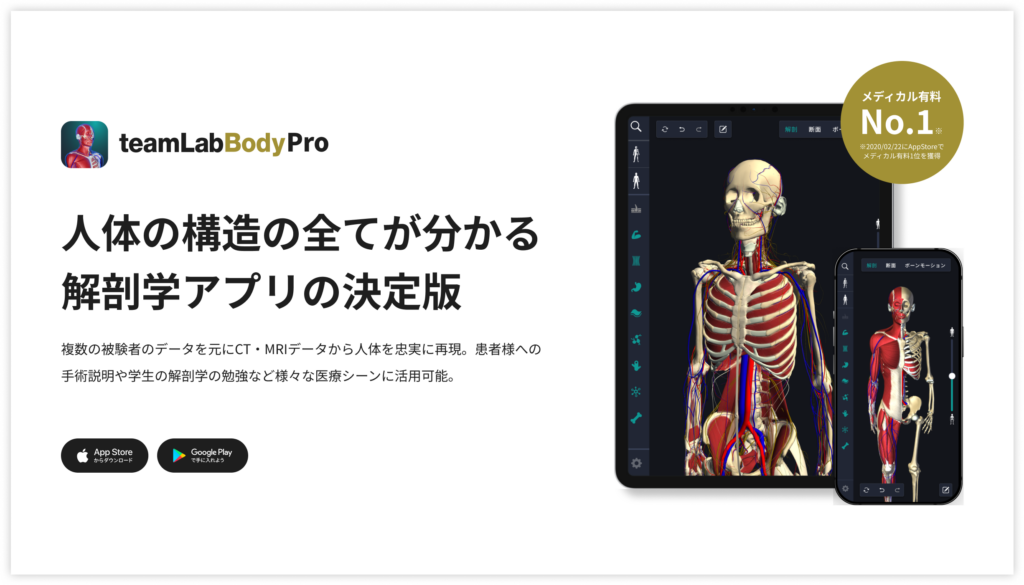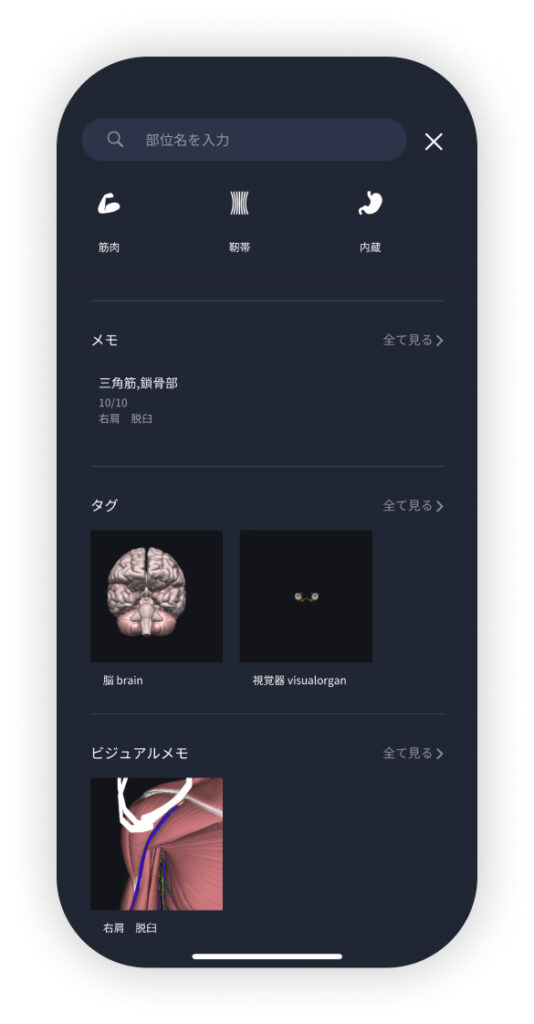beginning
In this article, I will explain effective study methods, starting with knowledge of specialized parts in human anatomy.
In human anatomy, it is necessary not only to memorize the names of various organs, muscles, and bones, but also to remember where they are located in the body. Therefore, it is necessary to learn as efficiently as possible.
I hope you will deepen your understanding even a little by reading this article and using the app.
Now, I will explain the contents of the “frontal sinus” and how to study human anatomy.
teamLab Body Pro Free Download
A 3D anatomy app that shows all the structures of the human body
Download teamLab Body Pro here!

What is the frontal sinus?
The anatomy application allows you to view a selection of anatomy 3D models. In this model, there are various observation methods such as surfaces, cross-sections, and nervous systems. This time, I'll explain using an anatomy application.
About frontal sinuses

The frontal sinus is one of the sinuses located in the facial bone and is located within the forehead bone. The space connected to the nasal cavity adjusts nasal and facial pressure and supports airflow during breathing.
The frontal sinus is usually divided into 2 parts in adults and is arranged on the left and right frontal bones. Anatomically, it is located at the top of the nasal cavity and plays an important role in regulating the volume of air within the skull. The main function of the frontal sinus is to help humidify the air, heat it, and reduce weight, and in particular, it contributes to keeping the center of gravity of the head light.
Study points
Anatomical understanding: location and structure of the frontal sinus
The frontal sinus is a space located within the forehead bone (frontal bone) and connected to the nasal cavity. Anatomically, it is divided into left and right, and each borders the upper part of the nasal cavity. The inside of the frontal sinus is covered with mucous membranes, and this mucosa works with the air in the nasal cavity to regulate humidity and temperature. The frontal sinus is located deep due to the structure of the bone, so it cannot be directly felt by palpation. Therefore, in learning, it is effective to confirm the positional relationship and adjacent bone structures of the frontal sinus using CT scans or anatomical models.
Functional understanding: the function of the frontal sinus
The frontal sinus is mainly responsible for regulating facial pressure. This makes the air flow in the nasal cavity smoother and breathing is carried out efficiently. Furthermore, the mucous membrane present in the frontal sinus also plays a role in humidifying and warming the inhaled air, so as not to put a burden on the respiratory system. In addition, the frontal sinus plays a role in lightening part of the skull and also contributes to the overall balance of the head. When learning this, it is important to actually understand breathing techniques and the function of the nasal cavity, and learn by being aware of how air flow changes.
Practical application: diseases of the frontal sinus
Frontal sinusitis (sinusitis) is the most common disease associated with the frontal sinus. This happens when the mucous membranes in the frontal sinuses become inflamed and pus and secretions accumulate. When frontal sinusitis becomes chronic, it causes symptoms such as eyesight, headache, and facial pressure, and treatment is necessary. When studying these diseases clinically, it is important to understand the anatomical structure of the frontal sinus, and then learn how inflammation affects it and treatment methods (e.g. antibiotics and surgery).
How to study human anatomy
I will explain specific study methods using human anatomy applications.
Check your past learning history and practice repeatedly
Here are the steps to check your anatomy learning history and practice iteratively effectively.
1. Check your learning history in the app
Reviewing your learning history with the application is an important step in effectively advancing anatomy learning. First, launch the app and go to the learning history section from the main menu. Many anatomy apps are designed to show your progress in the form of graphs and lists, so you can visually check which parts you've learned about and how much time you've spent.
By using this data, you can understand which areas you have strengths in and where you need to spend more time and effort. We also recommend using a dedicated tag or notebook function to mark areas you are particularly weak at or where you need to relearn. Regularly checking your learning history and looking back on past learning content will lead to efficient review and deepening understanding.
2.Make a plan for iterative learning
Making an efficient repetitive learning plan based on learning history is extremely effective in promoting knowledge retention. First, identify weak points and areas where you need to relearn. Next, arrange these study items into a weekly or monthly calendar and create a specific study schedule. By proceeding in a planned manner, you can learn each part evenly and avoid packing in a large amount of information at once.
Using a task management app or digital calendar to set study reminders is effective. Also, it's important to have the flexibility to regularly review progress and revise plans as needed. By having goals and proceeding with your studies in a planned manner, you can efficiently acquire anatomical knowledge.
3.Use 3D features to learn visually
By utilizing the 3D function, learning anatomy is easier to understand visually. The 3D model shows the structure of the human body three-dimensionally, and each part can be observed in detail. This makes it possible to intuitively grasp positional relationships between deep muscles and organs that are difficult to capture in a planar view. For example, you can learn even the smallest details by rotating specific muscles and bones and zooming in and out.
Also, there are many apps that have the function of displaying cross-sectional views of each part using a 3D model, which is useful for deepening understanding of internal structures. This diversity of visual information helps with memory retention and improves immediate responsiveness in tests and practice situations. By utilizing the 3D function and learning visually, you can learn anatomy knowledge more deeply and efficiently.
Use the memo function concretely

Make notes so you don't forget the things and points you've noticed while studying. The memo function can be used for different purposes, such as inputting text, saving images, and writing memos. Tag your notes to make them easier to review later.
Test your learning regularly in the form of quizzes
Regularly testing what you've learned in a quiz format is a very effective way to anchor your anatomy knowledge. Quiz-style tests help you objectively grasp your level of understanding and areas you lack while repeating knowledge.
For example, by using a learning app to conduct quizzes every specific period, you can reconfirm what you've learned and strengthen your memory. There are a wide range of quiz formats, such as multiple choice questions, fill-in-the-blank questions, and short answer questions, and each helps understanding from a different angle and develops the ability to utilize various types of knowledge.
Get feedback
If possible, get feedback from other learners and experts. It helps you find your own gaps in understanding and areas for improvement. You can also keep yourself motivated to learn by regularly testing yourself. Feeling a sense of accomplishment and progress increases motivation for continuous learning.
summary
This time, I explained how to study “frontal sinuses” using an application!
Thank you for reading this far.
I would be happy if reading this article helped you learn about anatomy.
Learning is a long, never-ending journey, but I sincerely wish you all the best. Let's continue to study together and work hard for the national exam!
Please look forward to the next blog.
teamLab Body Pro Free Download
A 3D anatomy app that shows all the structures of the human body
Download teamLab Body Pro here!





